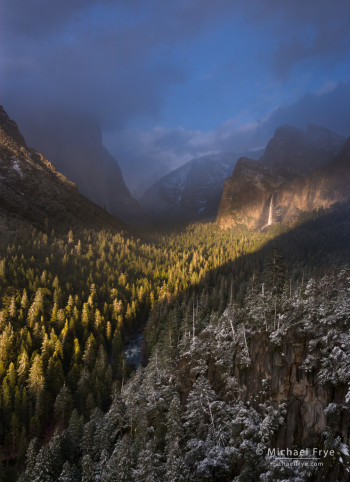I’m honored to be the guest on the Landscape Photography Show‘s hangout on Google+ tomorrow evening (March 11th), at 7:00 p.m. Pacific time. I’ll be talking about creating depth in landscape photographs – a rich topic that will allow me to expand on some of the ideas presented in my post Creating Depth: Beyond the Wide-Angle Formula, and delve into other related subjects.
If you can attend the live event you’ll have a chance to ask questions and join the conversation, but the show will also be recorded so you can watch it later on YouTube. You have to be a Google+ member to watch it live, but joining is free and easy. I hope to see you there!
— Michael Frye










Awesome! I’ll try to watch live
Great!
Best wishes for the hangout Michael. I’m going to try to be there but I think that’s at 3am GMT 🙁
There’s always YouTube 😉
What, you don’t want to stay up until 3 a.m.? 🙂
OK, the time isn’t as tough for us east-coasters as the GMT folks, but I’ll give it a try. Just need to figure out if it’s as simple as clicking on the “Landscape Photography Show” display window after signing into Google+
Robin, yes, I think it’s that simple. And if your eyelids start to droop you can always catch it later. 🙂
Beautiful photo, Michael. Great example of handling of light, forms, and color to recreate depth seen in gorgeous light.
Thank you Andrys!
Hi Michael I put my name dow to watch. Just realized it will be 3am Australian time.
Is it possible to get a recorded version later?
Sue
Sue, yes, they’ll post it on YouTube afterward.
I just watched. Very nice program!
Regarding where to focus:
– You mentioned setting the focusing ring halfway between the near and far points you want to be sharp (halfway on the ring, not half the distance). An issue with that is many lenses do not have distances listed on the focusing ring. Also, what f-stop would you use with this?
– The equally fuzzy approach (focus in the middle of the scene, change f-stop so foreground and background are equally fuzzy) sounds promising. I’ll have to try it.
Other possibilities:
– Chimping – guess, take shot, look at LCD, adjust repeat. An issue with this is it can be hard to judge sharpness on a small screen.
– Merklinger’s method (http://www.trenholm.org/hmmerk/DOFR.html). Essentially, focus at infinity, then set the f-stop so that the physical size of the aperture equals the smallest part of the foreground you want to resolve. Aperture equals focal length divided by f-stop.
– DOF charts or apps. This requires being able to estimate distances. Guessing 18″ is relatively easy, guessing 93′ is not easy.
There’s also the issue of balancing DOF and diffraction.
Your additional thoughts on the subject (or a blog post) would be much appreciated.
Thanks foosion!
>You mentioned setting the focusing ring halfway between the near and far points you want to be sharp (halfway on the ring, not half the distance). An issue with that is many lenses do not have distances listed on the focusing ring. Also, what f-stop would you use with this?
Some newer lenses do not have distances, but you can use the “equally fuzzy” method. The f-stop depends on how much depth of field you need, which depends on the focal length, the distance you’re focused at, and the range you need to get in focus. If you use the equally-fuzzy method, the more out of focus the foreground and background look, the smaller aperture you’ll need. Or just try it at, say, f/8, zoom in on the photo you just took, check the sharpness in the foreground and background, and stop down more if necessary.
I took a quick look at Merklinger’s method; doesn’t jive with my experience.
As you say, depth-of-field charts require estimating distances, which is a problem.
Yes, balancing depth of field with diffraction is an issue. In most cases I would rather have diffraction than an out of focus foreground or background.
Thanks for the reply!
My favorite is shoot, check LCD, adjust, repeat as necessary. “Equally fuzzy” seems to also use this technique 🙂
I agree about Merklinger, although it is popular with techies.
I also agree about diffraction. It’s easy to notice if one part of a picture is sharp and another is not (DOF difference) while it’s harder to notice a bit of overall softness with no comparison point (diffraction).
Thanks again
So sorry I missed that one but still I have a lot of questions on the landscape photography.As the landscape photography is just unique and different way of photography and the pictures are just looking as they are alive and in front of us.I really enjoyed to look at these pictures.
You can still watch the recorded show on YouTube if you follow the link.